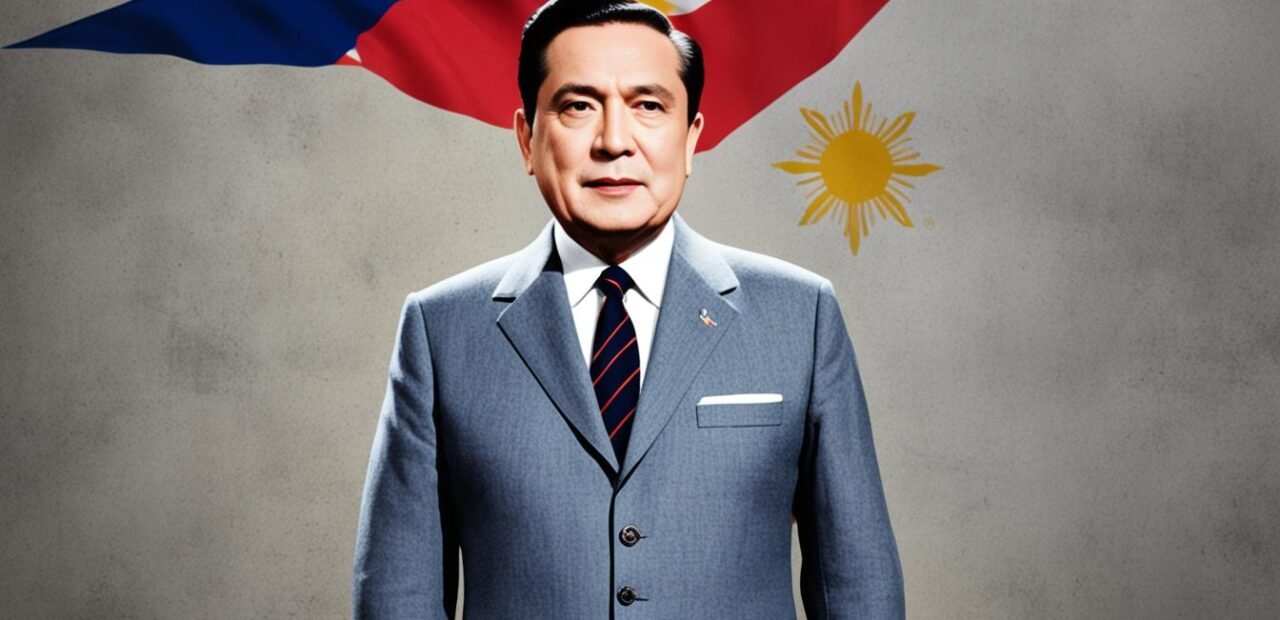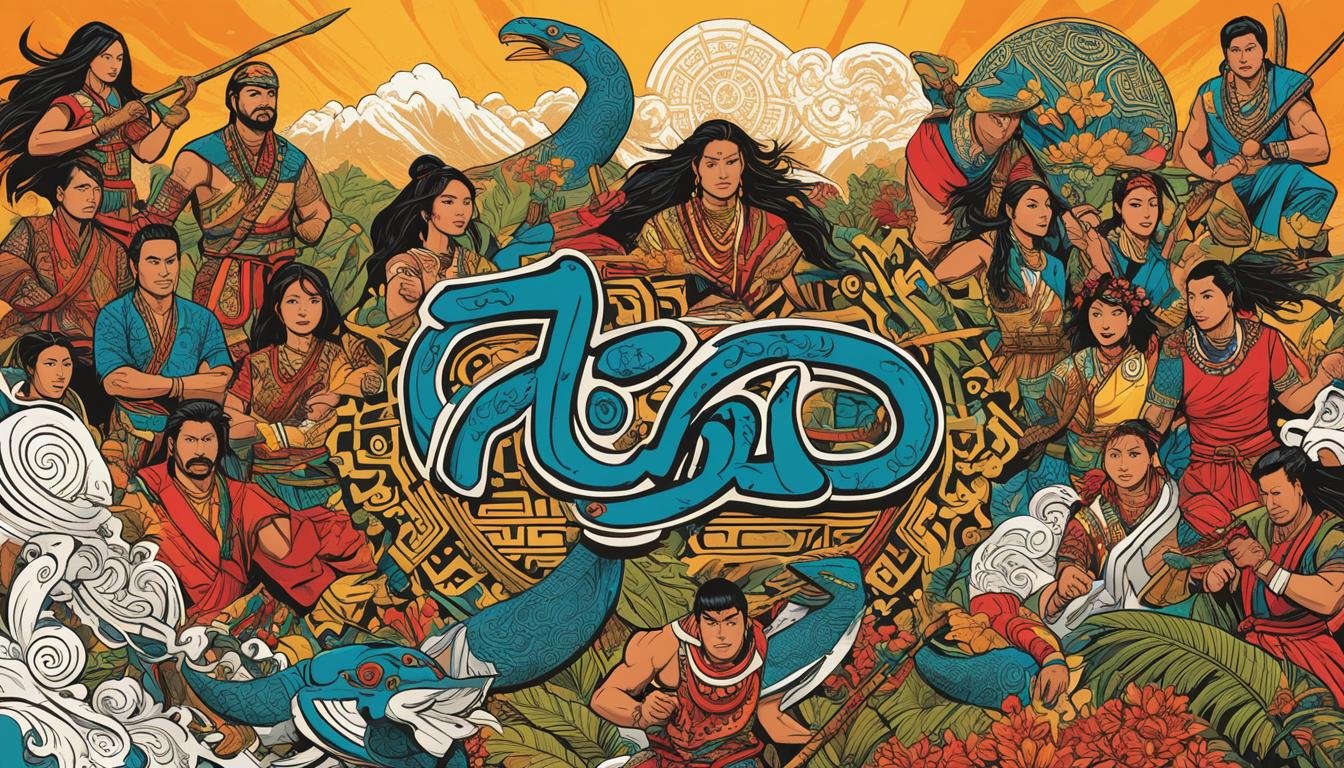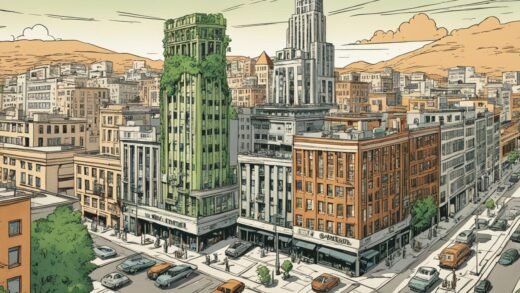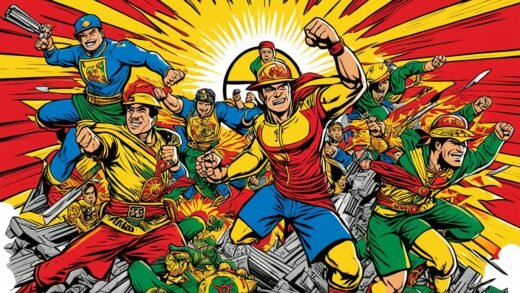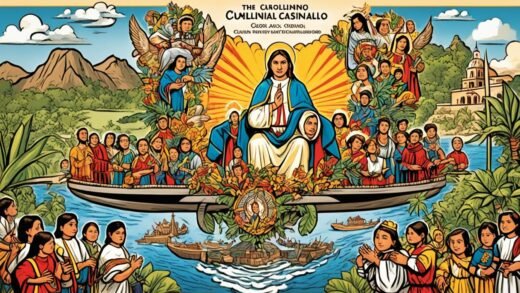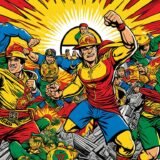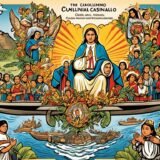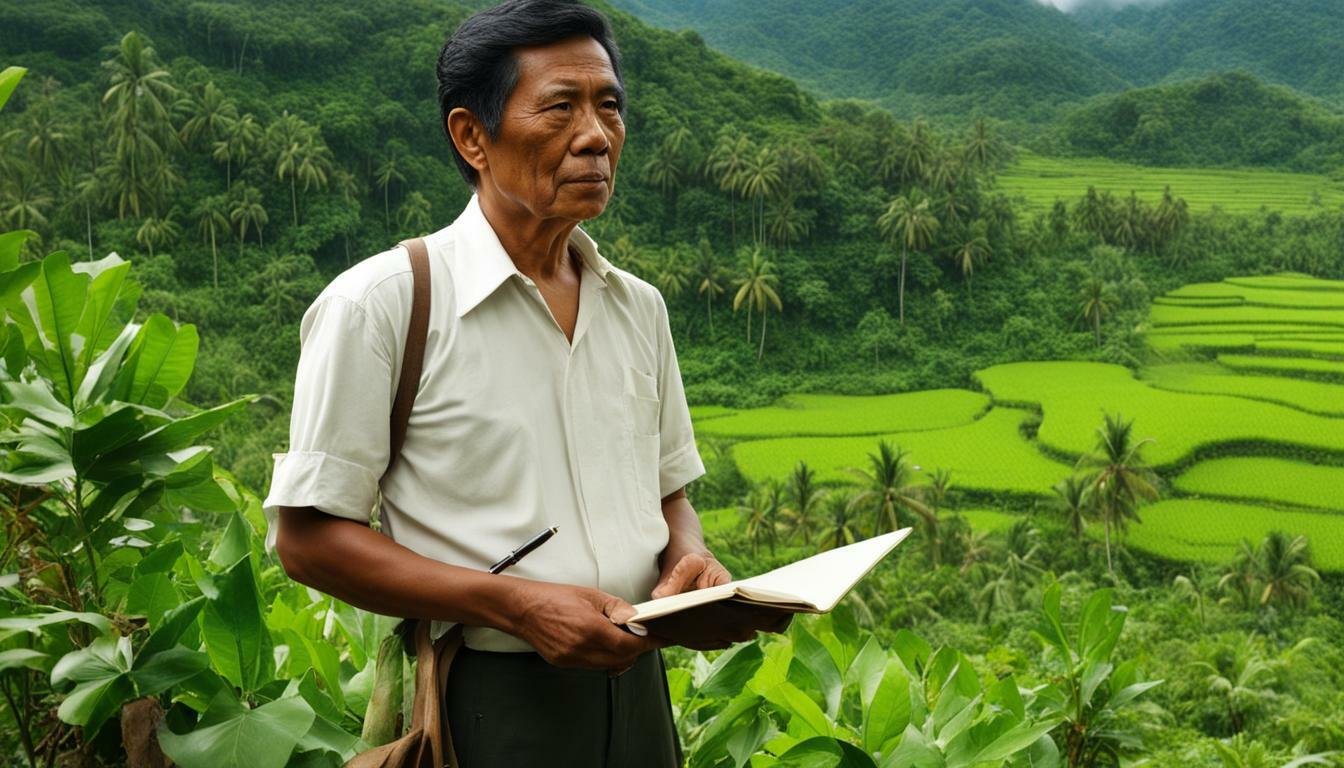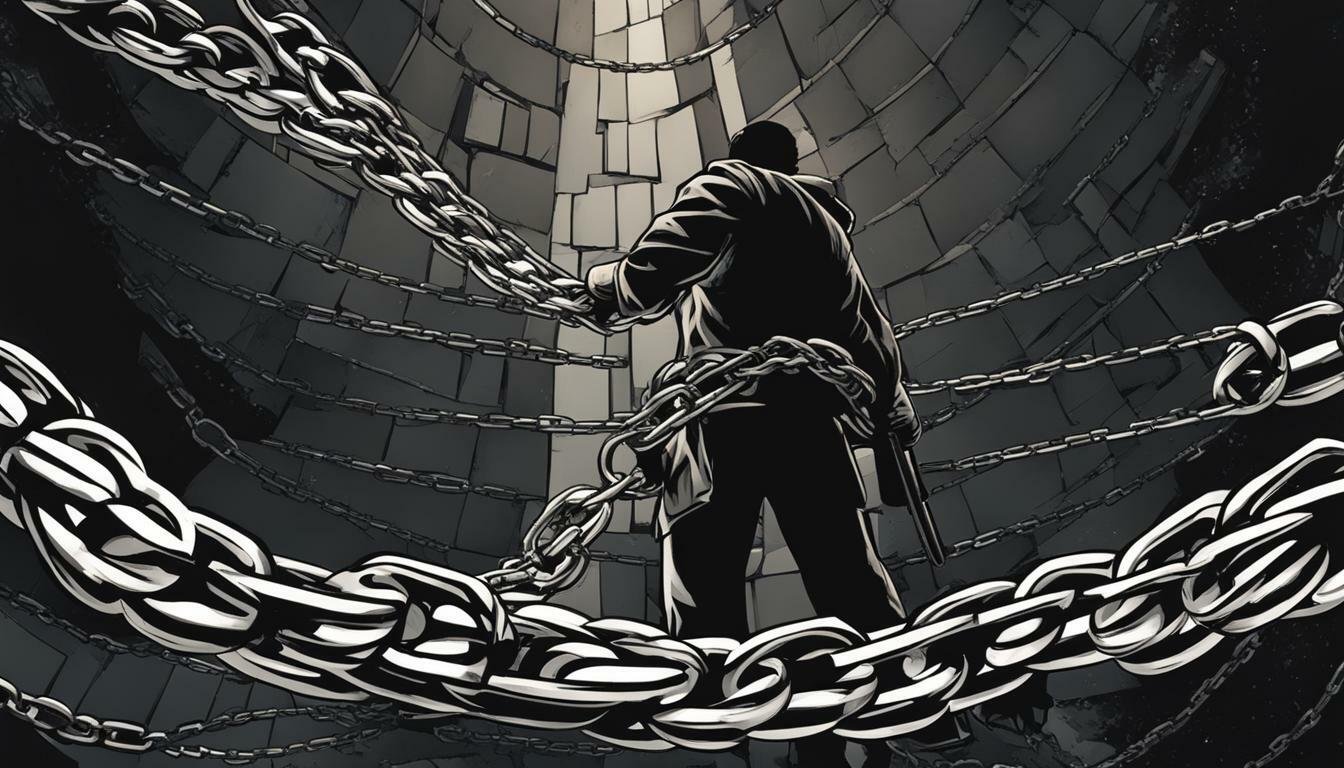Elpidio Quirino: The 6th President of the Philippines
Did you know that Elpidio Quirino served as the 6th President of the Philippines? From 1948 to 1953, he played a crucial role in the post-war recovery and reconstruction of the country. Let’s take a closer look at the life, political career, and legacy of this influential leader.
Key Takeaways:
- Elpidio Quirino was the 6th President of the Philippines.
- He served from 1948 to 1953.
- Quirino played a crucial role in the post-war recovery and reconstruction of the country.
Early Life and Legal Foundations
Elpidio Quirino, the 6th President of the Philippines, was born on November 16, 1890, in Vigan, Ilocos Sur, Philippines. His family had Chinese mestizo heritage, which influenced his upbringing and cultural background.
Birth and Family Heritage
Born into a family with Chinese mestizo heritage, Elpidio Quirino grew up with a diverse cultural background that would later shape his perspectives and approach to governance. His heritage is a testament to the rich and diverse history of the Philippines.
Education and Early Career
Quirino’s thirst for knowledge led him to study law at the prestigious University of the Philippines. After obtaining his law degree, he embarked on his early career as a lawyer, honing his skills and establishing a strong foundation in the field of law.
Entering Politics: From Law to National Leadership
Quirino’s passion for public service and desire to make a difference in the lives of his fellow Filipinos propelled him to enter the world of politics. He began his political journey as a representative, representing the interests of his constituents. His dedication and leadership qualities soon caught the attention of his peers, leading to his appointment as a senator.
As a senator, Quirino actively advocated for the welfare of the Filipino people, championing causes such as social justice and economic reforms. His commitment to public service and his ability to navigate the complex political landscape paved the way for his eventual rise to national leadership.
Elpidio Quirino’s Path to the Presidency
Elpidio Quirino’s journey to the presidency of the Philippines began with his role as Vice President under President Manuel Roxas. Quirino also served as the Secretary of Foreign Affairs, where he played a crucial role in shaping the country’s international relations.

The Vice Presidency and Secretary of Foreign Affairs
As Vice President, Quirino worked closely with President Roxas, contributing to the administration’s policies and initiatives. His experience in foreign affairs made him a valuable asset to the government, and he was appointed as the Secretary of Foreign Affairs. In this position, Quirino represented the Philippines on the global stage and played a vital role in strengthening diplomatic ties with other nations.
Ascension as President: The Transition after Roxas
Tragedy struck when President Roxas passed away, leading to Quirino’s ascension as President of the Philippines. Taking office during a time of post-war recovery and reconstruction, Quirino faced numerous challenges as he led the nation towards stability and progress.
Despite the difficulties he encountered, Elpidio Quirino’s presidency left a significant impact on the Philippines. His previous roles as Vice President and Secretary of Foreign Affairs equipped him with the necessary experience and knowledge to navigate the complexities of governance and international relations.
Challenges of Postwar Reconstruction
After World War II, the Philippines faced the daunting task of postwar reconstruction. Elpidio Quirino, as the president of the country during this critical period, had the responsibility to rebuild the nation and stimulate economic growth. His efforts focused on addressing the devastating impact of the war and laying the foundation for a prosperous future.
Rebuilding the Nation
Quirino prioritized the physical and social reconstruction of the Philippines. He invested heavily in rebuilding infrastructure, including roads, bridges, schools, and hospitals, to repair the damage caused by the war. He also implemented programs to provide housing and support livelihoods for the displaced population. Through these efforts, Quirino aimed to restore stability and improve the quality of life for the Filipino people.
Economic Revival Efforts
Recognizing the importance of economic stability for the overall recovery, Quirino implemented various initiatives to revive the economy. He focused on industrialization, agricultural development, and foreign trade to stimulate economic growth. Quirino implemented land reforms and established cooperatives to empower farmers and boost agricultural productivity. He also encouraged foreign investments and trade agreements to attract capital and create employment opportunities. Through these economic revival efforts, Quirino aimed to rebuild the nation’s economy and enhance the well-being of its citizens.
| Initiatives | Impact |
|---|---|
| Infrastructure development | Improved transportation and accessibility; facilitated economic growth |
| Land reforms and cooperatives | Empowered farmers; increased agricultural productivity |
| Foreign investments and trade agreements | Attracted capital; created employment opportunities |
Elpidio Quirino’s First Term: Key Policies and Actions
During Elpidio Quirino’s first term as president, he implemented several key policies and took important actions that shaped the Philippines’ future. Two significant endeavors during this period were establishing a new capital, Quezon City, and addressing the Hukbalahap insurgency.
Establishing a New Capital: Quezon City
One of the notable decisions made by President Quirino was the establishment of Quezon City as the new capital of the Philippines. This move aimed to modernize and centralize the government, as well as alleviate congestion in Manila. The new city was named after President Manuel L. Quezon as a tribute to his contributions to the nation.
The development of Quezon City included creating a master plan for urbanization, constructing government and commercial buildings, and designing residential areas. The move to the new capital symbolized progress and reflected President Quirino’s vision for a dynamic and thriving Philippines.
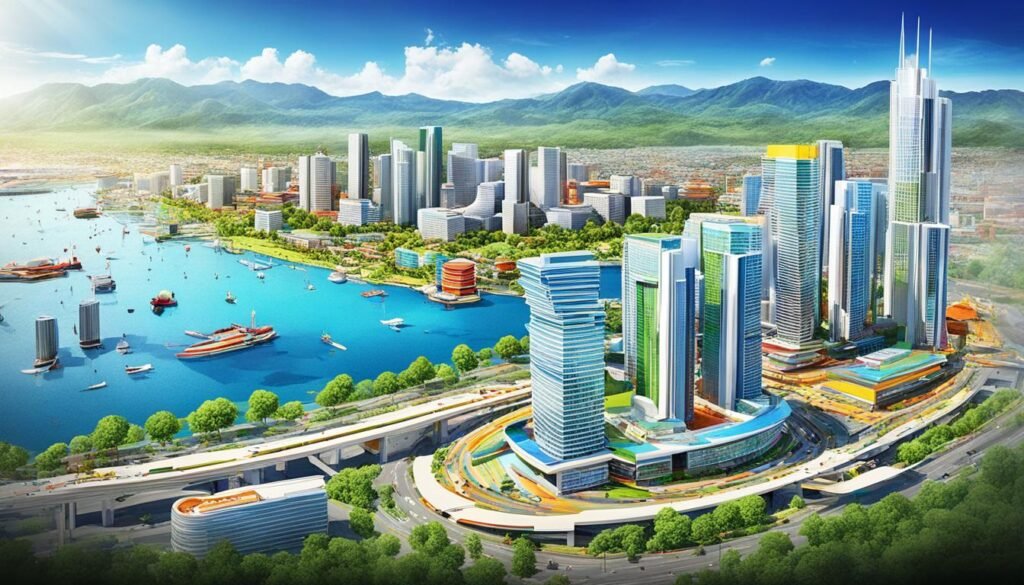
Addressing the Hukbalahap Insurgency
During Elpidio Quirino’s first term, he faced the challenge of the Hukbalahap insurgency. The Hukbalahap, or Hukbong Bayan Laban sa Hapon, started as an anti-Japanese resistance movement during World War II. However, it later transformed into an armed communist insurgency that aimed to address agrarian issues and social inequality.
President Quirino pursued a multi-faceted approach to address the Hukbalahap insurgency. His initiatives included military offensives, amnesty programs, and land reform policies. Through these efforts, Quirino aimed to bring peace and stability to the affected regions and alleviate the root causes of the insurgency.
The actions taken by Elpidio Quirino during his first term as president were crucial in shaping the future of the Philippines. His decision to establish Quezon City as the new capital paved the way for urban development and progress. Additionally, his efforts to address the Hukbalahap insurgency demonstrated his commitment to maintaining peace and fostering a more equitable society.
| Key Policies and Actions |
|---|
| Establishing a New Capital: Quezon City |
| Addressing the Hukbalahap Insurgency |
Domestic Policies and Social Reforms
During his presidency, Elpidio Quirino implemented a range of domestic policies and social reforms that aimed to address key issues and improve the lives of the Filipino people. His initiatives focused on land reform, improvements in public health, and advancements in education.
Land Reform Initiatives
Recognizing the importance of an equitable society, Quirino introduced land reform initiatives to address the unequal distribution of land in the Philippines. These reforms sought to provide land to landless farmers, promote agricultural productivity, and alleviate poverty in rural areas. By redistributing land holdings and implementing favorable policies for agricultural workers, Quirino made significant strides toward creating a more balanced and inclusive agricultural sector.
Improvements in Public Health and Education
Quirino also recognized the critical role of public health and education in national development. To enhance public health, he prioritized the establishment of health centers, hospitals, and medical facilities in both urban and rural areas. Additionally, he implemented measures to improve healthcare access, nutrition, and sanitation, leading to significant advancements in public health outcomes.
In the field of education, Quirino worked to expand access to quality education for all Filipinos. He increased investments in school infrastructure, encouraged teacher training programs, and initiated efforts to improve the overall quality of education. Through these reforms, Quirino sought to empower the Filipino youth with the knowledge and skills needed for a brighter future.
Quirino’s land reform initiatives, improvements in public health, and advancements in education not only contributed to the socio-economic development of the Philippines but also fostered a more inclusive and equitable society. His vision for social reforms aimed to uplift the lives of ordinary Filipinos and lay the foundation for a prosperous and progressive nation.
Foreign Relations and the Philippine International Stance
During his presidency, Elpidio Quirino played a pivotal role in shaping the foreign relations of the Philippines, positioning the country in the post-World War II international arena. Quirino recognized the importance of cultivating strong ties with the United States and worked towards strengthening US-Philippines relations.
Cultivating US-Philippines Relations
Quirino understood that fostering a close relationship with the United States was crucial for the economic and political stability of the Philippines. He sought to deepen the alliance between the two countries, emphasizing strategic cooperation, economic partnerships, and military assistance.
“We must cherish the friendship between our two nations and work together towards mutual progress and peace. The United States has been a steadfast ally to the Philippines, and we aim to forge an even stronger bond.” – Elpidio Quirino
Quirino’s efforts in cultivating US-Philippines relations included promoting trade agreements, encouraging foreign investment, and fostering diplomatic dialogue. Through his proactive approach, he aimed to secure favorable terms for the Philippines in the global arena, while also addressing shared concerns and interests with the United States.
Philippines in the Post-WWII International Arena
The aftermath of World War II presented the Philippines with new challenges and opportunities in the international arena. Quirino recognized the need for the Philippines to assert its presence and influence on the global stage, despite being a smaller nation in comparison to superpowers like the United States and the Soviet Union.
Quirino strategically navigated the complexities of the post-war international landscape, actively participating in multilateral organizations such as the United Nations and the Southeast Asia Treaty Organization. He advocated for the principles of self-determination, sovereignty, and non-interference in international affairs.
By actively engaging in international diplomacy and promoting the Philippines’ interests, Quirino sought to bolster the country’s stature and ensure its voice was heard in matters affecting the Asia-Pacific region and beyond.
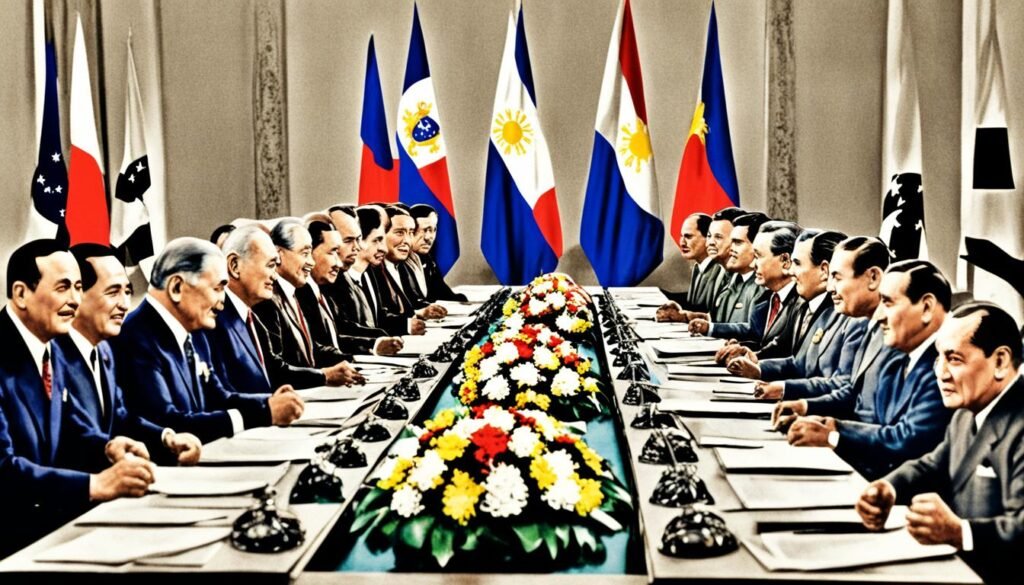
| Philippine International Stance during Quirino’s Presidency | Key Highlights |
|---|---|
| Active participation in the United Nations | Advocated for decolonization and the right to self-determination |
| Support for regional cooperation | Played a key role in the foundation of the Southeast Asia Treaty Organization (SEATO) |
| Strategic alignment with the United States | Promoted economic partnerships, military cooperation, and mutual defense agreements |
| Stressed the importance of non-interference | Upheld principles of national sovereignty and respect for the internal affairs of other nations |
Quirino’s efforts in cultivating US-Philippines relations and positioning the Philippines in the post-World War II international arena left a lasting impact on the country’s foreign policy. His strategic approach and steadfast commitment to diplomatic engagement helped shape the Philippines’ international stance during his presidency.
Cabinet and Administration
During his presidency, Elpidio Quirino assembled a cabinet and administration composed of key figures who played vital roles in his government. This section aims to highlight the individuals who served in the Quirino Cabinet, as well as examine the political alliances and leadership within the Liberal Party.
Key Figures in the Quirino Cabinet
The Quirino Cabinet consisted of notable individuals who held important positions in the government throughout Elpidio Quirino’s presidency. Some of these key figures include:
- Lauro L. Baja Sr.: Secretary of Foreign Affairs
- Jaime Hernandez: Secretary of Finance
- Tomas Cabili: Secretary of Defense
- Rafael Salas: Executive Secretary
- Angel Parazo: Secretary of the Interior
Political Alliances and Liberal Party Leadership
Elpidio Quirino’s presidency was closely linked to the Liberal Party, and his administration relied on political alliances forged within the party. As a leader of the Liberal Party, Quirino held the position of party chairperson. His leadership within the party helped shape its policies and direction during his presidency.
The Quirino Cabinet and the Liberal Party’s leadership played significant roles in shaping the policies and governance of the Philippines during this period. Their collaborative efforts aimed to address the challenges facing the nation and guide it towards progress and stability.
Elpidio Quirino
Elpidio Quirino was a prominent figure in Philippine politics and governance, leaving a lasting impact on the country’s history. His personal characteristics and leadership style played a significant role in shaping his overall contribution.
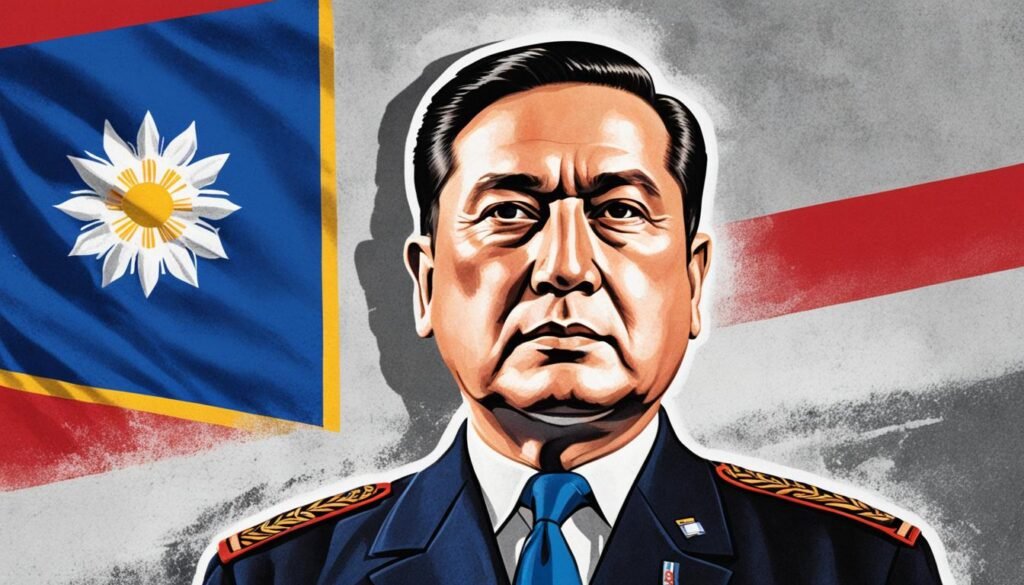
“Leadership is not a popularity contest; it’s about leaving your ego at the door. The name of the game is to lead without a title.”
Elpidio Quirino exhibited strong leadership skills throughout his career, prioritizing the needs of the nation over personal popularity. His dedication to public service and commitment to democratic values were evident in his governance style.
Quirino’s administration focused on post-war recovery and reconstruction, implementing policies aimed at rebuilding the nation’s infrastructure and economy. He recognized the importance of social reforms, implementing land reform initiatives and improving public health and education.
Furthermore, Elpidio Quirino played a crucial role in cultivating foreign relations, particularly with the United States. He recognized the significance of international cooperation in promoting the interests and welfare of the Philippines.
Overall, Elpidio Quirino’s legacy in Philippine politics and governance remains significant. His leadership during a challenging period in the country’s history reflects his commitment to serving the Filipino people and securing a better future for the nation.
Controversies and Critique: The Impeachment Attempt
During his presidency, Elpidio Quirino encountered controversies and faced critique, including an impeachment attempt. These events shed light on the issues of corruption that plagued his administration and the subsequent political ramifications.
Issues of Corruption and Their Political Ramifications
The allegations of corruption surrounding Quirino’s presidency had significant political ramifications. They raised concerns about the integrity and transparency of the government, undermining public trust and confidence in the leadership. The controversies surrounding corruption tarnished Quirino’s reputation and impacted the perception of his administration’s effectiveness in addressing the needs of the nation.
Public Reaction and Historic Evaluation
The public reaction to the controversies and critique varied. Some segments of the population expressed disappointment and frustration with the perceived corruption within the government. Others defended Quirino, arguing that the allegations were politically motivated and lacked concrete evidence.
In terms of historic evaluation, the controversies surrounding Quirino’s presidency have shaped how historians and scholars assess his legacy. Some critics argue that his administration failed to effectively combat corruption and address the economic challenges facing the country. Others acknowledge the complex political landscape and the broader historical context in which Quirino governed.
Overall, the controversies and critique surrounding Elpidio Quirino’s presidency highlight the challenges of governance and the complexities of political leadership during a critical period in Philippine history.
Legacy and Historical Interpretations
Elpidio Quirino’s presidency left a lasting legacy and has been subject to various historical interpretations. As the 6th President of the Philippines (1948-1953), Quirino’s leadership played a crucial role in the post-war recovery and reconstruction of the country. His policies and actions shaped the nation’s trajectory during a critical period of its history.
After his presidency, Quirino continued to contribute to Philippine society. During his post-presidency years, he remained active in public service and played a crucial role in the Liberal Party. He also engaged in various diplomatic activities, promoting international relations and cooperation.
To this day, Elpidio Quirino is commemorated and remembered for his significant contributions. His legacy is celebrated through monuments, museums, and other forms of commemoration across the country. Quirino’s place in Philippine history reflects his dedication to public service and his commitment to the welfare of the Filipino people.
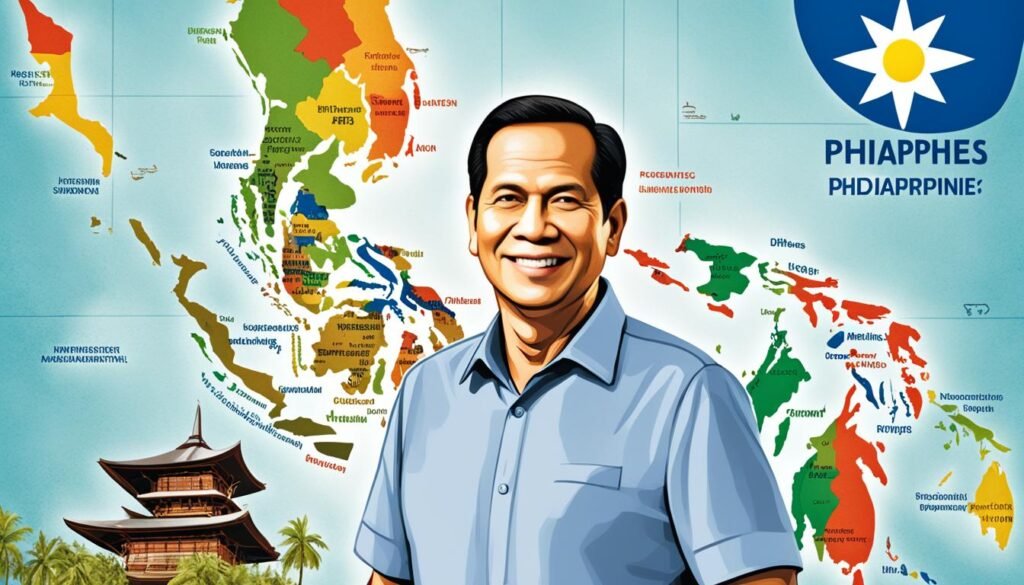
| Legacy | Historical Interpretations |
|---|---|
| Post-war recovery and reconstruction | Recognized as a key figure in rebuilding the nation and stimulating economic growth |
| Social reforms | Introduced land reform initiatives and improved public health and education |
| Foreign relations | Played a significant role in cultivating US-Philippines relations and shaping the country’s position in the international arena |
| Commemoration | Various monuments, museums, and commemorative activities honor Quirino’s contributions |
| Place in Philippine history | Remembered as a dedicated leader and champion of the Filipino people |
The 1949 Presidential Election: A Contentious Victory
The 1949 presidential election marked a significant turning point in Philippine history, as it propelled Elpidio Quirino to the presidency amidst contentious dynamics and allegations of electoral fraud. This section will explore the election campaign dynamics that shaped the outcome and provide insights into the allegations of electoral fraud.
Election Campaign Dynamics
The 1949 presidential election campaign was characterized by intense competition and political maneuvering. As the Liberal Party candidate, Elpidio Quirino faced strong opposition from former President Jose P. Laurel, who ran under the Nacionalista Party. Both candidates employed various tactics to garner support and secure victory.
The election campaign was marked by spirited speeches, rallies, and extensive grassroots mobilization efforts. Quirino focused on appealing to the masses and emphasizing his commitment to social welfare programs and economic development. Laurel, on the other hand, championed nationalist principles and advocated for self-reliance and protectionist policies.
The intense campaign period saw both candidates traveling extensively throughout the country, addressing the concerns and aspirations of the Filipino people. It was a fiercely contested election that captivated the nation and fueled a great deal of political excitement and engagement.
Insights into Electoral Fraud Allegations
Despite the passion and excitement surrounding the 1949 presidential election, it was marred by allegations of electoral fraud. Accusations of voter intimidation, ballot tampering, and irregularities in the vote-counting process surfaced, casting doubts on the integrity of the election results.
Electoral fraud allegations were primarily directed towards Laurel and his party, with accusations of using violence and coercion to manipulate the outcome in their favor. These allegations, although contested by the Nacionalista Party, raised concerns about the fairness and legitimacy of the election.
The precise extent and impact of electoral fraud during the 1949 presidential election remain subjects of historical debate and inquiry. While investigations were conducted at the time, the controversy and complexity of the allegations made it challenging to reach definitive conclusions regarding their validity.
Nonetheless, the contentious nature of the election and the existence of electoral fraud allegations highlight the complexities and challenges associated with the democratic processes of the time. It underscores the importance of ensuring fair and transparent elections to uphold the democratic principles and provide a legitimate mandate for those elected to office.
Cultural Impact and Presidential Presence
Elpidio Quirino’s presidency left a lasting cultural impact on Philippine society. His leadership and presence as the President of the Philippines influenced various aspects of the nation’s culture. From state ceremonies to the role of the First Lady, Quirino’s presidency played a significant role in shaping the cultural landscape of the country.
Victoria Quirino González: First Lady Duties at a Young Age
One notable figure in Quirino’s presidency was Victoria Quirino González, his daughter, who assumed the role of the First Lady at a young age. As a result of Quirino’s early widowhood, Victoria stepped into the traditional responsibilities of the First Lady, including hosting official events, supporting charitable initiatives, and representing the nation alongside her father. Her involvement in these duties at such a young age made her a well-known and influential figure in Philippine society.
State Ceremonies and Presidential Influence on Culture
State ceremonies held during Elpidio Quirino’s presidency had a significant impact on Philippine culture. These events, such as presidential inaugurations, official visits, and national celebrations, not only showcased the pomp and pageantry of the nation but also reflected the president’s influence on cultural norms and traditions. Quirino’s participation in and organization of these state ceremonies played a crucial role in defining the cultural identity of the Philippines during his presidency.
To further understand the cultural impact and presidential presence of Elpidio Quirino, let’s take a closer look at how his daughter, Victoria Quirino González, fulfilled her First Lady duties at such a young age and examine the significance of state ceremonies in shaping national culture.
End of an Era: The 1953 Election and Aftermath
The 1953 election marked the end of Elpidio Quirino’s presidency and brought about significant changes in Philippine politics. The nation witnessed the rise of Ramon Magsaysay as a prominent political figure, signaling a transition of power and an era of democratic processes.
The Rise of Ramon Magsaysay
Following the 1953 election, Ramon Magsaysay emerged as a formidable leader, capturing the attention and support of the Filipino people. Magsaysay, a former Secretary of National Defense under Quirino’s administration, appealed to the masses with his commitment to reform, anti-corruption stance, and dedication to the welfare of the common people.
Under Magsaysay’s leadership, popularly known as the “Man of the Masses,” significant changes were introduced, focusing on uplifting the lives of ordinary Filipinos. His administration prioritized agrarian reform, social welfare programs, and the fight against communist insurgency, earning him widespread admiration and support.
Transition of Power and Democratic Processes
The transition of power from Elpidio Quirino to Ramon Magsaysay symbolized the democratic processes ingrained in Philippine governance. The peaceful transfer of authority showcased the nation’s commitment to upholding democratic principles and the will of the people.
Magsaysay’s victory marked a shift in the political landscape, leading to reforms in governance, economic policies, and social programs. His presidency became a turning point in Philippine history, with significant strides made in social and economic development, foreign relations, and the improvement of democratic institutions.
As the era of Elpidio Quirino came to an end, the rise of Ramon Magsaysay ushered in a new chapter in Philippine politics, characterized by dynamic leadership, reforms, and an unwavering commitment to democratic processes. The nation embarked on a transformative journey under Magsaysay’s presidency, laying the foundation for a brighter future.
Conclusion
In conclusion, Elpidio Quirino holds a significant place in Philippine history. As the 6th President of the Philippines, he played a crucial role in the post-war recovery and reconstruction of the country. Through his leadership, Quirino implemented key policies and initiatives that aimed to rebuild the nation and stimulate economic growth.
Quirino’s contributions to domestic policies were particularly noteworthy. He advocated for land reform initiatives, working towards a more equitable distribution of land. Additionally, he prioritized improvements in public health and education, recognizing their importance in building a strong and prosperous society.
Furthermore, Elpidio Quirino’s presidency had a lasting impact on Philippine foreign relations. He fostered strong ties with the United States, cultivating a valuable partnership that benefited the country in the post-World War II international arena.
As we reflect on Quirino’s governance and legacy, it is evident that his presidency represents a significant period in Philippine history. His commitment to rebuilding the nation and implementing social reforms has left a lasting imprint. Elpidio Quirino will always be remembered as a leader who navigated the challenges of his time and fought for the betterment of the Filipino people.

